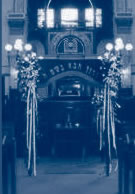|
SEDRA: KEDOSHIM HERTZ CHUMASH P. 497 Leviticus
Ch. 19 This week's Sedra is generously sponsored by Trevor Cohen
SYNOPSIS:
The people of Israel are to be "Kedoshim" a holy
people. This level can be attained by observing the principles
of ethics and morality enunciated in this Sedra and the Torah
in general. Specific reference is made to respect for parents,
Shabbat observance, the rejection of idol worship and the
maintenance of high ethical standards in interpersonal relationships.
Repulsive behaviour such as child sacrifice to Molech, witchcraft
and the like are condemned. Also heathen mourning rites, interbreeding
of animals, mixing of strands of wool and linen offend the
Divine laws of nature.
The Jew is to be distinguished for his compassion, special
consideration for the poor, the stranger and the handicapped
- not for the benefit of those individuals alone, but also
to refine his own personality as a virtue in itself. The corners
of the field, gleanings and the forgotten sheaves are for
the poor. All dealings are to be based on total honesty. Lying,
stealing and slandering are to be strictly avoided. Workmen
are to be promptly paid. Honesty in business, in weights and
measures is to be maintained. Judges must be completely unbiased.
Defamation and misleading the blind or naive is denounced.
Everything is to be done to save an endangered life. Hatred
and revenge is anathema to the guiding golden principle :
"Love your fellow as yourself".
Great care must be taken to refrain from immorality especially
adultery, incest and bestiality. The people of Israel are
to make a holy lifestyle - a life of high standards - their
ideal.
HAPHTORAH HERTZ CHUMASH P. 494 Ezekiel 22: 1-19
The haphtorah continues to exhort the Jew to the ideal of
Holiness. The prophet admonishes Israel for its failure to
live up to these ideals by sinning in the most corrupt way
and becoming morally degenerate. This will inevitably lead
to destruction.
TELL ME RABBI ..... THE MAFTIR ALIYAH
Maftir is a special aliyah. First the two Torah blessings
are recited and the final verses of the Sedra are reread from
the Torah. On special occasions, Festivals and Rosh Chodesh
a special section is read from a second Torah as Maftir. The
person called for Maftir generally reads the Haphtorah from
the Prophets, which is said following the Torah reading on
all Sabbaths and holidays. This is preceded by the blessing
before the haftarah which is chanted in the appropriate melody
of the Haphtarah.
It is this aliyah that is usually reserved for a Bar Mitzvah,
a special honour and celebrating a special occasion in one's
life. The person who receives this honour is usually notified
in advance so that he may prepare himself. Some haphtarot
are reserved for the Rabbi.
WHAT TO DO WHEN CALLED UP FOR HAGBAH AND GELILAH
After the Torah reading is completed, two persons are honoured
with the task of lifting up the Torah - Hagbahah, and rolling
and dressing it - Gelilah. The Talmud views the honour we
call hagbahah as embodying the spiritual reward of all the
aliyot combined (Megillah 32a). Tradition has, in fact, reserved
hagbahah for the most distinguished members of the congregation.
(OH 147:1, MB; 5-7).
Procedure for Hagbah
* Roll open the Torah scroll so that at least three columns
of script and a seam are visible.
* Grasping each of the eitz hayim handles, slide the Torah
scroll toward you until it is halfway off the reading desk.
Then, bending the knees, apply leverage downward. Bring the
scroll to an upright position and lift it upward as you straighten
yourself up. Holding the Torah aloft, turn your body in all
directions, or at least somewhat to the right and left, so
that the Torah script can be seen by everyone in the congregation
which is the whole purpose of this ritual.
* The Congregation sing "V'zot Hatorah ......" "This
is the Torah that Moses set before the Children of Israel
(Deut. 4:44); by the hand of Moses according to the command
of G-d" (Num 9:23).
* The Torah is then laid down on the Desk, rolled together,
placed onto the right shoulder, and the person doing Hagbahah
sits down at the rear of the Bimah. The person honoured with
Gelilah binds and dresses the Torah Scroll. In some Congregations
(not in ours), a young boy may be sent up to take the Torah
and hold it until it is time to return it to the Ark.
Procedure of Gelilah
* Take hold of the eitz hayim handles at the top of the scroll
and roll them together. The right eitz hayim handle (to the
left of the person doing gelilah), which contains Bereshit
(ie.the beginning of the scroll,) should rest above the left
eitz hayim handle.
* Then bind the Torah with the sash about half to two-thirds
way up the scroll. There are many kinds of sashes. The bow
or the buckle is set at the front of the Torah, facing the
person holding it. Now place the Torah mantle on the Torah,
making sure that the front of the mantle is aligned with the
front of the scroll. The silver breastplate is put on next
over the mantle. The Yad (pointer) is slipped over both of
the handles. The crown (keter) of the Torah, or two finials
(rimonim) are put on last. When dressing the Torah is complete,
kiss it before returning to your seat.
AFTER RECEIVING A SYNAGOGUE HONOUR
* When returning to your seat following an aliyah or other
honour people often extend their hand and say yasher koah,
meaning "more power to you". (Sticklers for Hebrew
grammar use the form of yiyasher kochacha). It's the equivalent
of saying "well done". The expression, is first
used in Talmudic story in which Moses is complimented by G-d
for having broken the first tablets of the The Commandments
(Shabbat 887a, Yevamot 62a), at the incident of the Golden
Calf. You may respond with Kochacha Yiyasher or simply with
baruch tiheyeh " may you be blessed".
* It is a traditional courtesy on the way back to one's seat
to go up to the Rabbi and Gabaim to acknowledge the honour.
They will be delighted to greet you appropriately.
you appropriately.
BACK TO SHABBAT SHALOM
TABLE
|








